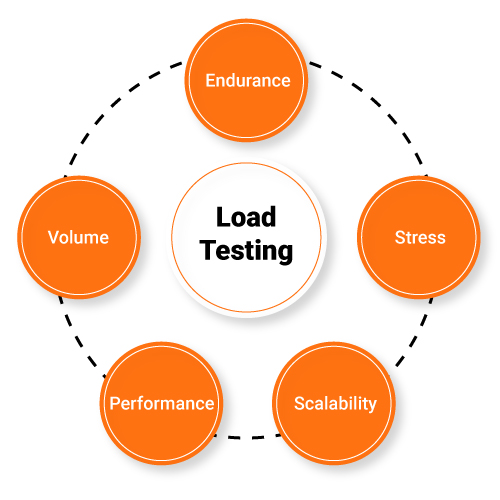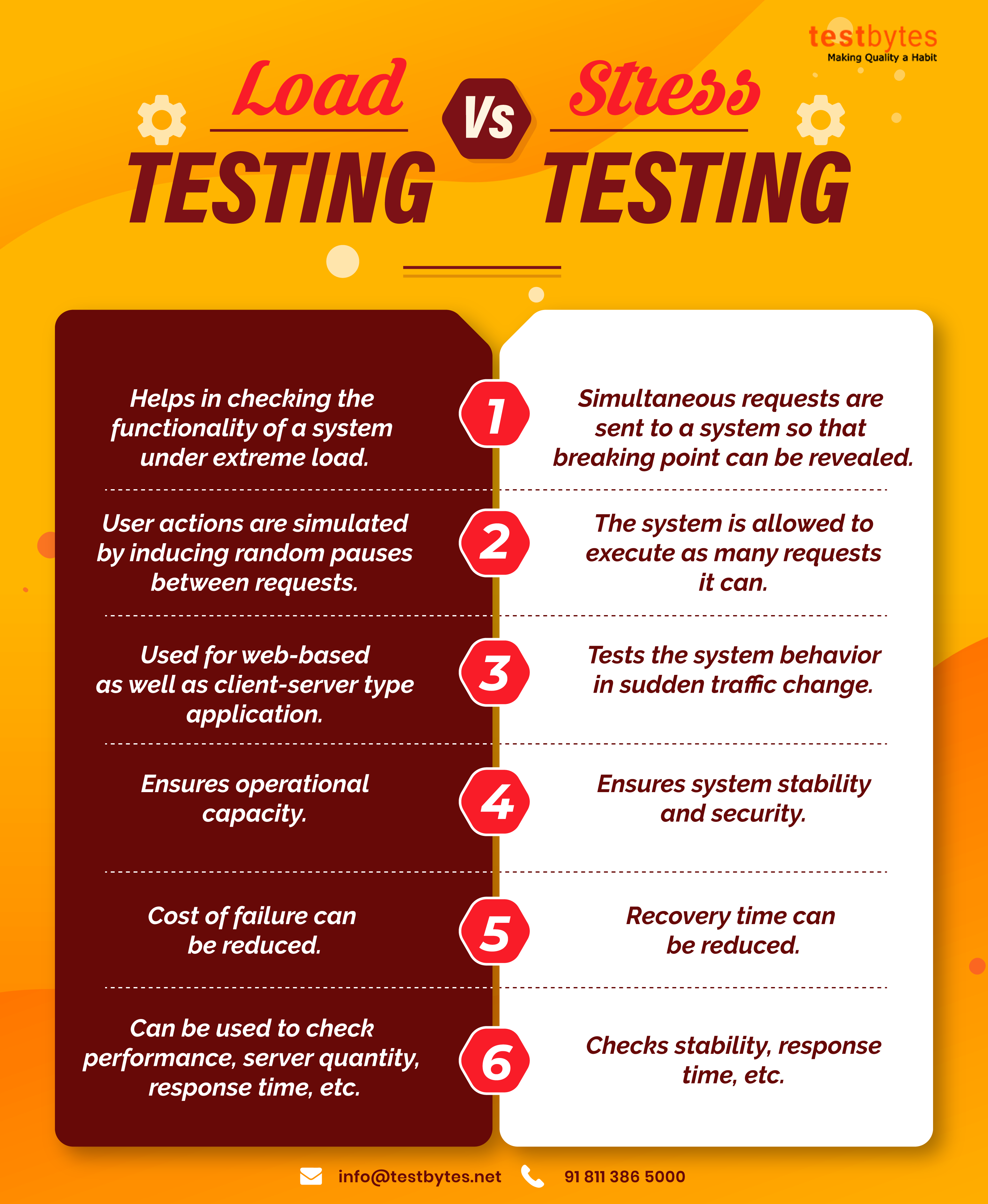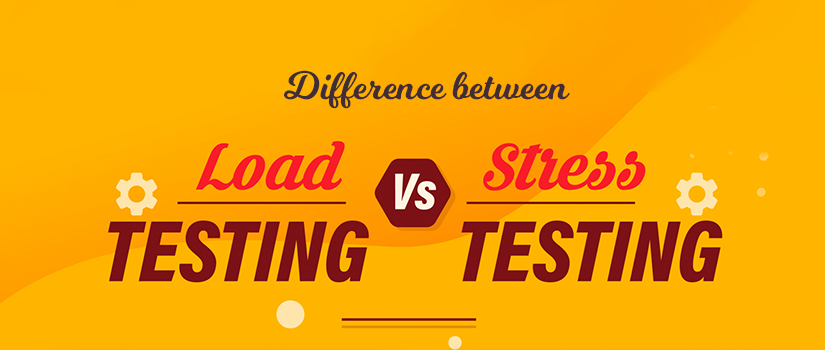Load Testing vs Stress Testing what’s the striking differences between both the process?
In the following sections, we will discuss in detail load and stress testing. People often get confused between these 2 and refer to them as a load and stress test. But there are fundamental differences between these 2 performance tests, as we will discuss in the upcoming sections. These are the 2 most important performance tests that you may wish to see the results for before your product or application goes live. This is especially true for applications that are connected to the internet.
Load Testing
As the name suggests, in a load test, many users are loaded into the system or application, and then the transactions are performed to see how well they work. Load test gives you an idea of how your application would perform in the real world with “n” numbers of users (referred to as the load) active in the system.
The results of a load test are generally expressed in terms of TPS or transactions per second. This means the system can process “N” transactions per second with an active user load of “X” thousand. The value for “N” and “X” needs to be defined by the business based on the expected number of users and the infrastructure you have in place to handle this load.

Stress Testing
In Stress testing, the system is put under stress and then its performance is measured. It is used to verify the stability and reliability of the system under stress. It is also done to ensure the system does not crash at any point.
Considering your application can handle 1o0 concurrent users. In a stress test, you may start by having 100 or more users in the system performing data transactions. Slowly you would stress the system by either increasing the load or having more transactions performed. Then you would monitor how your application is performing in this stressed situation. The stress test is also performed to understand at which point your system is likely to crash or break.

Major Differences between Load and Stress Testing?
Here are some major differentiation points between load and stress testing.
| Sno | Load Testing | Stress Testing |
| 1 | It is used to check the performance/functionality of the system under load (multiple active users) | It is used to test the reliability of the system under stress or extreme load |
| 2 | The load is set up with multiple active users – virtual or real – inserted into the system | Stress is created by creating more users, data, and transactions in the system |
| 3 | Load test helps to identify the upper limit of the users that the system can handle. | A stress test is used to understand the behavior and reliability of the system under extreme load or stress. |
| 4 | The performance of the app is measured with load in the system | The reliability and stability of the system is measured under extreme load or stress |
| 5 | Some of the load testing tools are Jmeter, NeoLoad, Headspin, Experitest, etc | Some tools recommended for stress testing are Stress Testers, Jmeter, NeoLoad |

Examples of load and stress testing
To better understand the difference between load and stress testing, let us look at an example. Let us take an example of an online shopping site. Assuming that your application is designed to handle 1000 concurrent users. When you do a load test, you may want to start with a 50% load. So, you set up your systems to simulate 500 users and then check how the system responds by checking the API response times. If the response time is within acceptable limits, you progressively increase the load to 700, 800, 900, and 1000 to see how your application performs under the different loads.
For the same application, if you were to do a stress test, you will 1000+ users simultaneously generating calling multiple APIs. This will stress out the system which is designed to handle only 1000 users. The reliability of the system is then checked by checking the correctness of the API response, to check if the application or pages crash at any point, the data is saved to and from the database, etc.
Some other examples of load testing are sending multiple files for printing at the same time to the printer, sending thousands of emails at a time to load the mail server, or changing large volumes of data in a word or excel or any other processing system.
Some scenarios that emphasize the need for a stress test are an educational website at the time of result declaration, or eCommerce website during their annual sales or new and anticipated product launches, or the latest vaccination availability and booking apps as well.
Wish to know about the best performance testing tools in the market? Read here!
Performance testing includes various types of testing including Load, Stress, and others. A performance test is done to validate the reliability and stability of the system, ensure the response time is within the defined SLA, and also ensure that the system is scalable.
Load test only concentrates on the performance of the application or system with many active users or with a load. Hence, Load testing can be considered as a subset of the performance test.
What is the purpose of load testing?
The main purpose of Load testing is to understand, how the system would perform under the real-life load. For this, the business first needs to analyze the expected user base for the application. Then a load similar to that number is simulated and the performance of the system is measured. The results are normally mentioned as successful transactions per second under “X” load or “X” active users.
It is very helpful in understanding the achievable performance of business-critical transactions along with resource utilization. Based on the load test result, the business decides to scale up or scale down the backend infrastructure.

What are the different types of load and stress testing?
Load testing can be further divided into 4 different categories based on the load used. These are
- Load Testing: Here you simply check the performance of the system under different levels of load which are well within the expected load limits.
- Capacity Testing: Also called scalability testing capacity testing is mainly done to identify the maximum load the system and the infrastructure can take without breaking down or without breaching the SLA.
- Stress Testing: It is done to find out how the system performs under stress or extreme load. This is achieved by reducing the infrastructure, reducing the database size along increasing the load many folds.
- Soak Testing: It is a long-form of load testing where system performance or degradation in performance is monitored over a long duration.
How are load and stress testing done?
Every application or system will have a limit to the load it can handle at a particular time. This limit is decided by the size of the database and servers used. Both in load and stress testing, load or stress in the system is simulated using real users or using tools.
Load testing is done with real users and with simulated users as well. When real users are used, due to the limitation to the number of users available to database, servers, and other infrastructures are scaled down to create a load on the system. Then the testing is performed and the response times are calculated. The results are then extrapolated to derive the performance numbers for the actual infrastructure. When tools are used, any number of users can be simulated, so the actual infrastructure is tested.
Stress testing can be performed only with the help of tools. Here the system is put under stress by having inserting users many-folds than the expected told, or by putting stress on the DB and servers with many transactions and API calls. The aim is to check the stability and reliability of the system under extreme load. It also helps to identify the point at which the system is likely to crash. Based on the results of the load and stress testing, the business may decide to scale up the infrastructure for better application performance and reduced downtimes.
What are the goals of load and stress testing?
The goal of load and stress testing in to find the performance defects in the application and in the infrastructure or network that can affect the application.
The main goals of load testing are:
- To ensure that under different permissible the response time for all the transactions is within the SLA (Service Level Agreement) as fixed by the business.
- To measure the performance of different application modules under different loads.
- To measure the network latency and other components that can impact the response time.
- To uncover application design issues that can reduce the performance.
- To check the server configurations for web and application to ensure they can handle the load.
The main goals of stress testing are:
- To uncover issues that occur only at extreme load conditions.
- To check the stability and reliability of the application under heavy load.
- To uncover synchronizations issues, memory leaks, and race conditions
- Optimizing the system to prevent a breakdown in production.
- Planning for the scalability and best utilization of the available infrastructure.
Do you know that volume testing is absolutely needed before app release? Read more
Soak Testing is a type of Performance Testing where the performance of the system under load is analyzed for long-duration similar to a production scenario. Some applications need to be online 24/7 like the eCommerce websites. They may have a different load at different points, a soak test would put the system under test with a specific or varying load and monitor its performance for hours or even days.
A soak test aims to identify issues that occur only after the system has been active for long durations. The most common issue identified in a soak test is related to memory leaks where the system starts degrading after being live for a long time.
Conclusion
The performance of a software application is critical to the success of the application. For this purpose after the functional testing, performance tests are performed. The most common performance tests are load and stress tests. Based on the results of the load and stress test the business decides on the infrastructure needed to support the application.
The load and stress result thus play a very important part not only in the success of the application but also helps business in optimizing resource utilization and improved profit.
